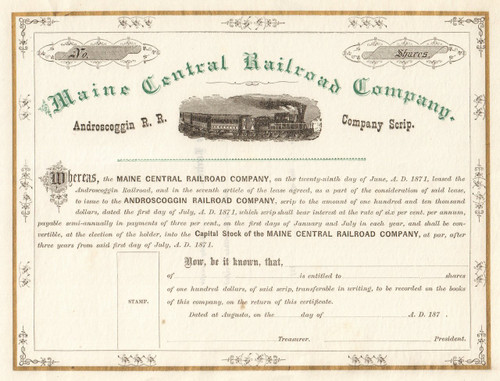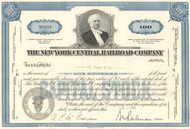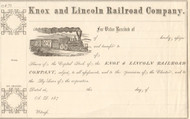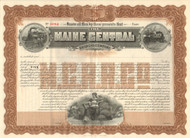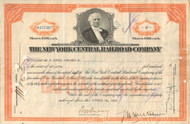Categories
Categories
- Home
- Railroad
- 1800's Railroads
- Maine Central Railroad Company 1870's stock scrip
Maine Central Railroad Company 1870's stock scrip
Product Description
Maine Central Railroad Company stock scrip 1870's
Nice railway collectible. Great vignette of steam train with passenger cars. Unissued and not cancelled. Dated 187_. Androscoggin RR Company scrip covertible to shares in the Maine Central Railroad Company after 1871.
The Maine Central was created in 1862 through the merger of the Androscoggin and Kennebec Railroad and the Penobscot and Kennebec Railroad, resulting in a line from Danville to Bangor. The line connected with the Grand Trunk Railway on its Portland-Chicago mainline at Danville and with the Bangor and Piscataquis Railroad in Bangor. As a result of its connection with the Grand Trunk, the Maine Central initially operated on a track gauge of 5 ft 6 in known as "Canadian" or "Portland gauge".
Maine Central purchased the Portland and Kennebec Railroad, which ran from Portland to Augusta and was built to standard track gauge, since it connected with the Boston and Maine Railroad at Portland. By 1871, the Maine Central completed its conversion to standard gauge to facilitate interchange of cars.
The MEC established rail service to the Penobscot Bay in 1871 by leasing the then just-completed 33-mile of track built by the Belfast and Moosehead Lake Railroad (B&ML). Maine Central operated the road as its "Belfast Branch" for the next 55 years, but on June 30, 1925, MEC President Morris McDonald gave the B&ML the required six months notice that it would not renew its lease. The B&ML took over operation of its road on January 1, 1926. It continued to exchange passengers and mail with the MEC at their jointly owned station at Burnham Junction until 1960 and freight interchange traffic until 2002.
In 1882, Maine Central leased the European and North American Railway (E&NA) between Bangor and Vanceboro. In 1889, the Canadian Pacific Railway purchased trackage rights from the Maine Central on the portion of the former E&NA from Mattawamkeag to Vanceboro. This Maine Central track formed part of the CPR's Montreal-Saint John mainline, upon completion of the International Railway of Maine.
In 1888, the Maine Central leased the Portland and Ogdensburg Railroad, which ran from Portland, through the White Mountains of New Hampshire via Crawford Notch, and into St. Johnsbury, Vermont, where it connected with the Southeastern Railway. Maine Central also operated a line southeast from Bangor along the coast through Machias to Calais, with branches to Bucksport, Bar Harbor and Eastport. Maine Central gained stock control of the Sandy River and Rangeley Lakes Railroad in 1911 and the Bridgton and Saco River Railroad in 1912, and operated both as narrow gauge branch lines.
The Maine Central was at its height by 1917 when it became nationalized during World War I under the United States Railroad Administration, having track which extended over 1,358 miles. It ran from Vanceboro, Calais and Eastport in the east, to Portland in the south, St. Johnsbury, Vermont in the west, and to Lime Ridge, Quebec in the north. It also operated resorts and coastal steamships and ferries.
Following World War I, Maine Central began retracting. It sold or abandoned lines such as the narrow gauge logging systems, as well as its ferries and steamships. In the 1930s it began to change its locomotives from steam-powered to diesel-powered. Beginning in 1933, Maine Central entered into a "joint management" agreement with the Boston and Maine Railroad, with which it shared the Portland Terminal Company. Faced with increased competition from cars, trucks and buses, Maine Central operated its last passenger train on September 5, 1960, and continued to reduce its freight business to reflect changing traffic.
In 1980, the railroad was purchased by U.S. Filter Corporation and was then sold in 1981 to Guilford Transportation Industries, which later purchased the Boston and Maine Railroad (and thereby the Portland Terminal) in 1983 and the Delaware and Hudson Railway in 1984. By the mid-1980s, Guilford began to rationalize its system and fully one-third of Maine Central's track was eliminated, including the "Mountain Division" from Portland to St. Johnsbury, Vermont; the "Rockland Branch" from Brunswick to Rockland; the "Calais Branch" from Bangor to Calais; and the "Lower Road" from Augusta to Brunswick. Guilford also forced many management and salary changes, resulting in a major strike against the company in 1986. Guilford Transportation also moved the Maine Central's headquarters from Portland to North Billerica, Massachusetts in the mid-1980s.
In the early 1990s, Guilford ended its practice of putting the full "Maine Central" name on the long hoods of MEC locomotives. Instead, the locomotives would wear the "Guilford Rail System" moniker, with small "MEC" reporting marks underneath the cab windows. On November 1, 2003, the Morristown and Erie Railway (M&E) took over the former Maine Central "Lower Road" and Rockland Branch routes. M&E is operating these state-owned lines as the Maine Eastern Railroad. Prior to M&E, the Rockland Branch had been operated by Safe Handling, and before that, the Maine Coast Railroad.
In the first quarter of 2006, Guilford Transportation Industries officially changed its name to Pan Am Systems, reflecting GTI's purchase of Pan American World Airways in 1998. The rail division of GTI changed its name from Guilford Rail System to Pan Am Railways (PAR). PAR began repainting locomotives in the sky-blue Pan Am colors shortly thereafter.
 Loading... Please wait...
Loading... Please wait... 
